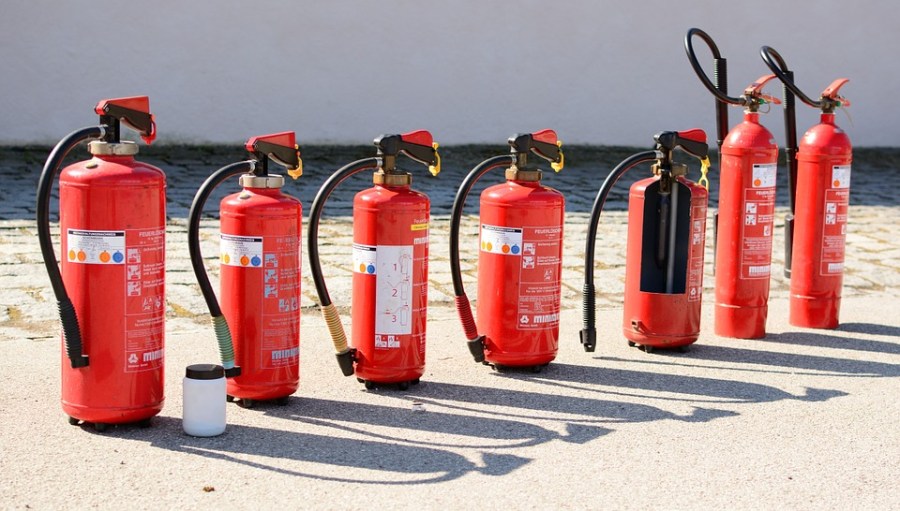How to Draw a Fire Extinguisher in Autocad

Each year in the United States, fires in homes and apartments injure or kill thousands of people and cause billions of dollars worth of damage. Having a fire extinguisher around can not only prevent your own home from becoming damaged in a fire, but it can save your life and the lives of any loved ones and pets who live with you. It's really something every home should have on hand. If you want to add a fire extinguisher to your house, learn how to choose the right one and how to use it.
The Five Types of of Fire Extinguishers
When choosing a fire extinguisher, the first thing you need to know is that there are five different types: A, B, C, D and K. Most of the time, homeowners will only need A, B and/or C. D is for working with flammable metals and is only usually found in factories. K is for working with certain types of cooking oils and is usually only found in restaurants and commercial kitchens. A is the most common, and it works on most items you have around your house, like wood, paper and fabric. B works best on combustible items, like grease or paint. C works on electrical fires that may occur at outlets and within cords to appliances and tools. When you look at the label, it will list the type, though it may have a number in front of it, like 3-A. The number is meant to signify how well that particular fire extinguisher does its job.
Tips for Selecting a Fire Extinguisher
One you know the five types of extinguishers, you probably have a good idea of what you need for your home. The National Fire Protection Association recommends having one on each floor of your home, along with one in your garage. It should be kept by an exit in an easy-to-reach space. Fire extinguishers come in a variety of sizes. It's best to choose one you can handle, as well as what's appropriate for you space. A stovetop one is ideal for small kitchen fires, and you can keep a two-pound one in your car. Five-pound is ideal for your kitchen or laundry room, while 10 pounds is perfect for a garage, basement or areas where a fire may start without you noticing it at first. Replace your fire extinguisher every 10 years.
When Should You Use a Fire Extinguisher?
When you have a fire in your home, you have to think quickly to stay safe, and that means knowing when it's appropriate to try to use your fire extinguisher. For example, if you are injured or the fire extinguisher is too heavy or awkward for you to use, you're putting yourself at risk by attempting to use it. you'll also want to make sure you're not putting others at risk by alerting anyone in your home that there's a fire before you attempt to put it out. Make sure you have a clear path to get out of the room or building in the event that you are unable to put out the fire. you'll also want to make sure someone in the home calls the fire department and make sure you're not breathing in toxic smoke while you extinguish the fire. Finally, it's best to only use an extinguisher on a fire that is small or contained to a space like a garbage can, pan or sink.
PASS Method for Using a Fire Extinguisher
Now that you know when to use a fire extinguisher, it's time to learn how to use it. Most fire safety experts teach people via the PASS method. PASS is an acronym for the steps you take when you spring into action. They are:
- Pull the pin to unlock the device. Make sure the nozzle is aiming away from you.
- Aim low. Always spray towards the base of the fire.
- Squeeze the lever slowly.
- Sweep the nozzle from side to side as you spray.
While children should never use a fire extinguisher, it's a good idea to take some time to teach other adults in your home how to use it in case of an emergency.
Maintaining Your Fire Extinguisher When It's Not in Use
With any luck, you'll never actually need to use your fire extinguisher, and it can be easy to forget about it if it's tucked away in a cabinet or pantry. But it's a good idea to check on it every once in a while to make sure it's still functional and not too old to use. Unused extinguishers lose their pressure over time, and are typically no good after 10 to 12 years. At least once a year check to make sure:
- The fire extinguisher is still in an easy-to-reach spot in your home
- The pressure on the gauge hasn't gone too high or low
- The nozzle and hose are in good shape and free from rust, dents and other damage
- Dirt or grease hasn't built upon the extinguisher. If it has, you may need to wipe it down.
- The fire extinguisher is still in an easy-to-reach spot in your home
- The pressure on the gauge hasn't gone too high or low
- The nozzle and hose are in good shape and free from rust, dents and other damage
- Dirt or grease hasn't built up on the extinguisher. If it has, you may need to wipe it down.
Source: https://www.questionsanswered.net/article/how-to-choose-and-how-to-use-a-fire-extinguisher?utm_content=params%3Ao%3D740012%26ad%3DdirN%26qo%3DserpIndex
0 Response to "How to Draw a Fire Extinguisher in Autocad"
Post a Comment